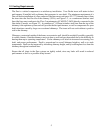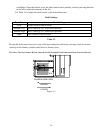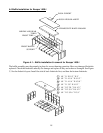
12
homes, could possibly cause smoke spillage into the room. Smoke may contain carbon monoxide,
which is poisonous, and in sufficient quantities is a health hazard.
11. We recommend that you have a fresh air or make up air supply for the insert. In Canada this is a
building code requirement. If this is not done, it could cause poor air quality in the home, poor
and incomplete combustion, and poor efficiency in the insert. Adequate ventilation is required to
reduce effects from room air starvation and exhaust fans.
Outside combustion air may be required if:
a. The solid-fuel-fired appliance does not draw steadily, smoke rollout occurs, fuel burns
poorly, or back-drafts occur whether or not there is combustion present.
b. Existing fuel-fired equipment in the house, such as fireplaces or other heating appliances,
smell, do not operate properly, suffer smoke roll-out when opened, or back-draft whether or
not there is combustion present.
c. Opening a window slightly on a calm (windless) day alleviates any of the above symptoms.
d. The house is equipped with a well-sealed vapour barrier and tight fitting windows and/or has
any powered devices that exhaust house air.
e. There is excessive condensation on windows in the winter.
f. A ventilation system is installed in the house.
3.2 Fuel
1. Fuel for the insert must not be stored closer than the required clearances to combustibles and not in
the space required for ash removal.
2. Your Drolet insert is designed to burn CORDWOOD FUEL ONLY. Do not burn coal, charcoal, or trash
in the unit. Highly flammable items such as trash may ignite creosote in the chimney, resulting in
a chimney fire. Never burn salt wood, beachwood, chemically treated wood, or wood removed
from salt water, since the deposits left will deteriorate the firebox. Damage caused by chemicals or
salt is not covered under warranty.
3. Seasoned dense wood is recommended. Wood should be air dried in a covered ventilated area for
six months to a year or more. This reduces the moisture content of the wood, resulting in better
insert performance. Wood species with a moisture content of 20% or less are ideal. Dry seasoned
wood can be distinguished from green wood by the checks or cracks in the ends.
4. Wet or green wood will tend to cause the fire to smoulder, producing large amounts of creosote.
Creosote build-up could result in a chimney fire. This wood will also prove difficult to keep
burning properly, and fires will tend to go out. Green wood produces very little heat, and
sometimes causes customers to think that the insert does not work. If you must burn wet wood,
use only small amounts mixed with dry wood.
5. Decayed wood or low density wood has very little energy content or heating value, and will not
burn satisfactorily for long periods of time.
An example of the energy values of some common wood fuels is given in Table 3.1


















